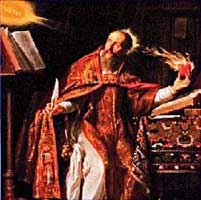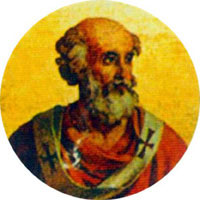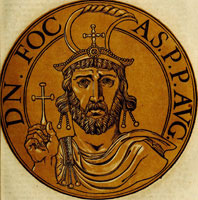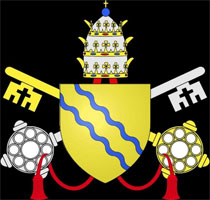Bonifatius means "good luck," or good fate in Latin. In English it is transliterated as Boniface.
Boniface needed more than "good luck" to defeat true Christianity which was flourishing in North Africa. He needed the help of Apollyon and his Muslims!
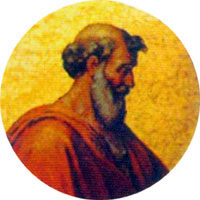 Pope Boniface I. Pope from 418 to 422. |
|
The last great pagan persecution begun under Emperor Diocletian was not as severe in North Africa as in the other parts of the Empire. The Christians there mainly spoke Latin, and they used the Old Latin Version called the Italia.
Augustine was the real author of the Koran. He denied the Holy Trinity and he called the Supreme Being Allah . . . which means "The EL" in Hebrew. Translated into English it means "The God." Mohammed was chosen as the messenger of Allah because Mohammed is the Arabic name for Apollyon!
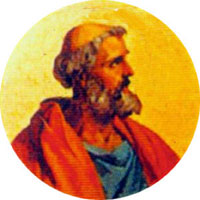 Pope Celestine I. Pope from 422 to 432. |
|
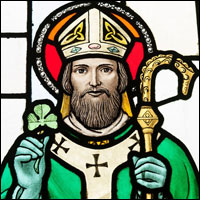 The real Saint Patrick (373–465) was morphed into a Babylonian bishop! |
Embarrassed by his failure, but buoyed by a sack of gold, he headed north to the birthplace of Saint Patrick. Palladius caused Saint Patrick endless grief, and almost shipwrecked his ministry, when he persuaded a boyhood "friend" of St. Patrick to reveal a youthful indiscretion to the elders of the Congregation. Saint Patrick wrote about that false brother in his Confession.
Palladius never returned to Roma, and he is buried very close to the birthplace of Saint Patrick, in present day Scotland.
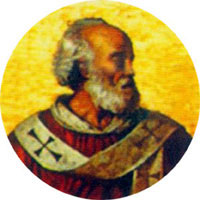 Pope Boniface II. Pope from 530 to 532. |
|
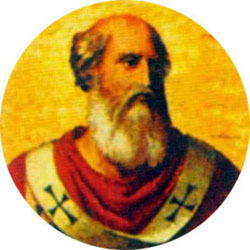 Pope John II. Pope from 533 to 535. |
It was during the pontificate of Boniface that a monk named Dionysius Exiguus contrived the calendar in present use that dates the Christian era from the birth of Christ, instead of his baptism during the 15th year of Tiberius Caesar. Later research has proven that the date was off by 4 years.
|
|
|
After he received that title, Boniface returned to Roma and was crowned Pope in 607. Most Bible scholars began the 1260 years of Papal supremacy from that fateful year, and they expected it to end in 1866. They were off by only 4 years!
 Pope Boniface IV Pope from 608 to 615. |
|
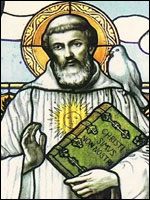 Saint Columban of Bobbio. (543–615). |
Irish Christianity had a lot more in common with Constantinople than with Roma. The Christians followed the Old Covenant pattern of devoting the firstborn to JEHOVAH, so the Christian mothers had no shortage of missionaries to swarm all over the Continent.
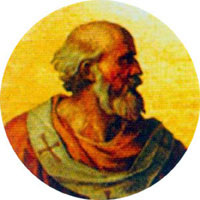 Pope Boniface V. Pope from 619 to 625. |
|
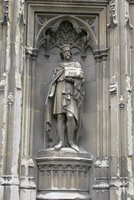 A statue of King Æthelbert of Kent (550–616) at Canterbury Cathedral. |
From the time of the arrival of Augustine and his monks, until the Babylonian Captivity of Britannia, the main theological conflict was between the Irish Congregation founded by St. Patrick, and the Latin monks from Canterbury.
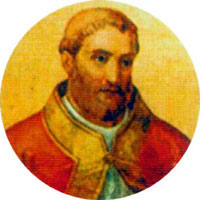 Pope Boniface VI (806-896). Pope from April 11 to 26, 896. |
|
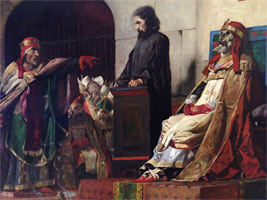 The trial of the corpse of Pope Formosus. Pope from 891 to 896. |
After being dead for 8 months, Pope Formosus was dragged from his tomb; clad in his papal vestments, and put on trial before his accusers. Obviously, he could not defend himself, so he was declared guilty. The papal vestments were torn from his body, the 3 fingers from his right hand that he used in "blessing" were cut off, and his body was thrown into the Tiber (later to be retrieved by a monk). That was one of the most infamous and shameful episodes in the long history of the Papacy.
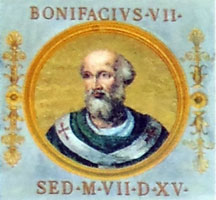 Pope Boniface VII. Pope in 974, and 984 to 985. |
|
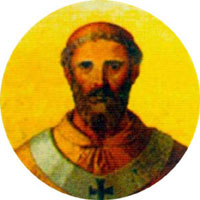 Pope Benedict VI. Pope from from 973 to 974. |
Most people who are knowledgeable about the Papacy are familiar with the next pontiff. He issued a Papal Bull that claimed the entire world as his fiefdom.
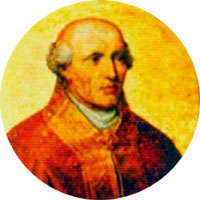 Pope Boniface VIII (1230–1303). Pope from 1294 to 1303. |
|
|
As a capstone on the gigantic pyramid of error that began in the 4th century, Pope Boniface VIII issued a Bull which declared that every human being on the earth was subject to the Papal monarch:
Furthermore, we declare, we proclaim, we define that it is absolutely necessary for salvation that every human creature be subject to the Roman Pontiff. (Unum Sanctum, November 18, 1302).
Islam united was capable of conquering the world, but Islam was a house divided between Sunni and Shia. It is beyond belief how that pontiff was going to conjure up the armies to make his outrageous claim a reality!
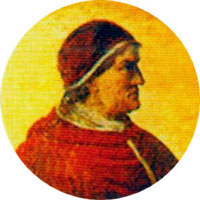 Pope Boniface IX (1350–1404). Pope from Nov. 1389 to 1404. |
|
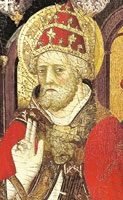 Avignon Pope Benedict XIII Pope from 1394 to 1423. |
Europe was still a house divided by the pontificates of Boniface and Benedict. The year 1335 was the last deadline for the "prophecy" of Joachim of Fiore to be fulfilled but Pedro de Lunatic still fought desperately for a Muslim world.
Pope Boniface IX was the last Boniface in the nightmarish Papal dynasty. The best way to rescue Catholics . . . and Muslims . . . from the Babylonian system is to present a true history of the Papal dynasty:
Flee out of the midst of Babylon, and deliver every man his soul: be not cut off in her iniquity, for it is the time of JEHOVAH's vengeance; he will render unto her a recompense (Jeremiah 51:6).
And I heard another voice from heaven saying, "Come out of her, my people, that ye be not partakers of her sins, and that ye receive not of her plagues" (Apocalypse 18:4).
Vital links
Reference
Wylie, Dr. J. A. History of the Scottish Nation in 3 Volumes. Andrew Elliot, Edinburgh, Scotland, 1886.
